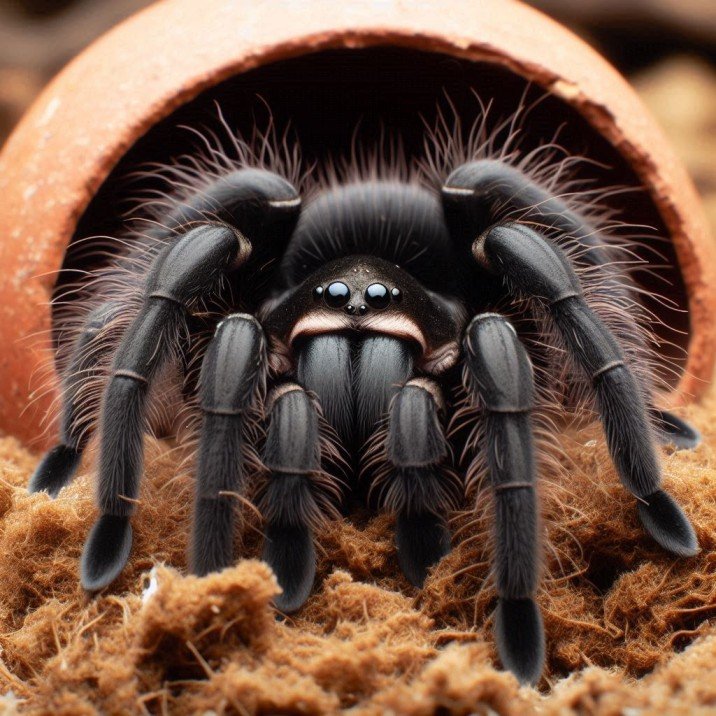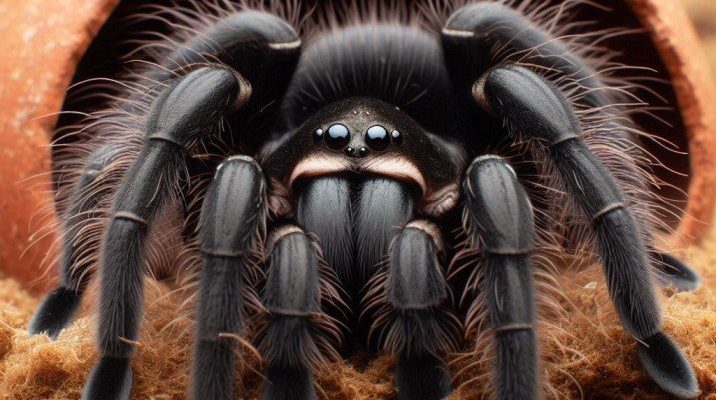
The Brazilian Black Tarantula is more than just a pretty face—it has unique characteristics and behaviors that make it stand out. Known scientifically as *Grammostola pulchra*, this tarantula hails from the lush forests of Brazil. You might be wondering why anyone would be interested in a spider. Well, these creatures play essential roles in their ecosystems, and they can teach us a lot about biodiversity, nature’s balance, and even the beauty of the unexpected! So grab a cup of coffee, and let’s explore some interesting facts about this incredible spider.
Physical Characteristics of the Brazilian Black Tarantula
Let’s start with what sets the Brazilian Black Tarantula apart visually. This species is known for its thick, shiny black legs and a large, robust body that can grow up to 5 to 6 inches in leg span! Just imagine that size—it’s like holding a small plate in your hand. The color of their bodies can vary slightly, but it generally stays dark, which helps them blend into the shadows of their forest habitat.
One of the most remarkable features is their long, silky hairs. These hairs help the spider sense its environment and can also play a protective role. When threatened, the tarantula can rub its legs together to release these tiny hairs and irritate potential predators. It’s kind of like a built-in defense mechanism! If you think about it, that’s a clever way to stay safe in the wild.
Another interesting thing is the spider’s ability to regenerate lost limbs. If a leg gets damaged or lost—say, during a scuffle—the Brazilian Black can grow it back in subsequent molts. This regeneration is just one more reason to admire these creatures and appreciate their resilience.
The Habitat of the Brazilian Black Tarantula
The Brazilian Black Tarantula thrives in the tropical forests of Brazil, where humidity and temperature remain relatively stable. Picture a dense, verdant jungle filled with towering trees and a chorus of animal sounds. That’s home sweet home for these spiders! They prefer to hide in burrows or under rocks, which provide protection from predators and harsh weather conditions.
In the wild, this tarantula is often found at the base of trees or in leaf litter. Their habitat plays an essential role in their survival. The moisture in the soil helps with their hydration needs, as they don’t drink water like many other creatures. Instead, they absorb moisture from the environment. So, next time you’re in a lush forest, consider the hidden wonders that might be lurking nearby.
Sadly, due to deforestation and habitat loss, the Brazilian Black Tarantula’s living space is shrinking. Conserving their natural habitats is crucial not only for their survival but also for maintaining biodiversity. This tarantula is a vital player in the ecosystem that can influence a variety of other species.
Behavior and Social Structure
Brazilian Black Tarantulas are generally known for their solitary nature. Unlike some other spider species that live in groups, these tarantulas prefer to keep to themselves. You might think of them as the introverts of the spider world. They’re perfectly happy snuggling into their burrows or taking a leisurely stroll around their territory.
When it comes to hunting, these tarantulas are ambush predators. They don’t spin webs like the more familiar house spiders. Instead, they rely on their keen eyesight and lightning-fast reflexes. Once they spot their dinner—typically insects or small rodents—they pounce! Does that make you think of how cats hunt? It’s a similar idea — stealth followed by speed.
Interestingly, during mating season, males will roam in search of a female, which can lead to some pretty dramatic encounters. Sometimes these meetings can be dangerous for the males, as females may view them as a potential meal. Talk about the risks of romance, right?
The Diet of the Brazilian Black Tarantula
So, what exactly does a Brazilian Black Tarantula eat? Their diet usually consists of various insects, including crickets, roaches, and grasshoppers. They can also munch on small mammals or reptiles if they’re lucky enough to catch one. Think of them as the ultimate pest controllers in their ecosystem!
Feeding time is an interesting spectacle. Instead of munching like many animals do, these spiders inject digestive enzymes into their prey, essentially turning their insides into a soup. Then, they suck in the liquid, which is quite different from how we eat! It’s a bit of an acquired taste, I suppose. You wouldn’t want to switch places with them at mealtime!
In captivity, they can live on a diet of crickets and roaches, making them relatively easy to care for as pets. However, if you ever decide to keep one, be sure to research how to provide the right conditions for them to thrive. Their diet is crucial for their health and longevity.
Handling and Care for Pet Brazilian Black Tarantulas
If you’re thinking of owning a Brazilian Black Tarantula, here are a few things to consider. First off, they’re known for their calm demeanor. Many enthusiasts say they handle surprisingly well, which can be a relief if you’re nervous about keeping a tarantula. However, remember that every spider has its own personality—some might be a bit feistier than others!
When setting up their habitat, make sure to replicate their natural environment as closely as possible. This means providing a spacious terrarium with plenty of hiding spots, like logs and plants, and maintaining the right humidity levels. Temperature is also essential—aim for around 75 to 80 degrees Fahrenheit. You really want to create a cozy home for your eight-legged friend.
It’s also crucial to feed them appropriately and keep an eye on their health over time. You’ll want to monitor for signs of molting, which can affect their wellbeing. If you notice any unusual behavior, like a lack of appetite, don’t hesitate to consult a vet who specializes in exotic pets.
Conservation and Importance of the Brazilian Black Tarantula
As we wrap up our exploration of the Brazilian Black Tarantula, it’s important to touch on conservation efforts. These spiders play a significant role in their ecosystems, helping to control insect populations and serving as food for larger animals. When we lose such creatures, we disrupt the entire web of life.
Unfortunately, habitat loss is a real threat to the Brazilian Black. Deforestation and urbanization are erasing their homes, making it more important than ever for us to take action to protect them. Supporting conservation programs or organizations can make a difference for these fascinating spiders.
In addition to helping the tarantulas themselves, protecting their habitats means preserving the countless other species that share their environment. The survival of the Brazilian Black Tarantula reflects the overall health of its ecosystem, which benefits us all. After all, every species matters!
In conclusion, the Brazilian Black Tarantula is a remarkable creature that’s much more than just a spider. From its stunning physical features to its important role in the ecosystem, there’s so much to appreciate about this fascinating species. Whether you’re a budding spider enthusiast or just curious about the natural world, recognizing the beauty of these creatures—and the need to protect them—is essential for our planet’s health. So next time you think about spiders, remember: sometimes the most extraordinary things come in unexpected packages!

